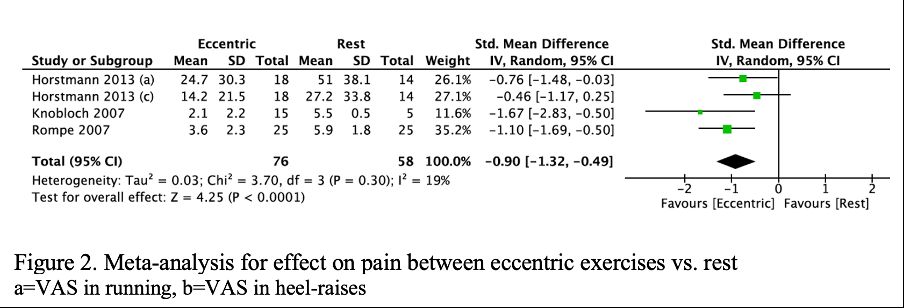Background: Achilles tendinopathy (AT) is a common musculoskeletal condition characterised by the presence of pain, stiffness, swelling, impaired function and performance. Eccentric exercises (EEs) are well-established and commonly prescribed for the treatment of AT. Previous reviews on this topic have compared EEs with or without co-interventions for AT, primarily focusing on pain and function.
Aim/s: To determine the efficacy of EEs compared to other exercise interventions or rest on pain, disability, activity participation, quality of life (QoL) and patient-rating of condition outcomes in managing AT.
Methods: The current review followed the Preferred Reporting Items for Systematic Reviews and Meta-Analysis (PRISMA) 2020 guidelines. A systematic search was undertaken using eight databases: Web of Science, SCOPUS, PubMed, AMED, EMBASE, Medline, PsycINFO and PEDro. Studies with at least one group receiving EEs for AT were included. The quality assessment of included studies was performed using the PEDro scale. The certainty of the evidence was assessed using the Grading of Recommendations Assessment, Development and Evaluation (GRADE).
Results: Out of 1880 records obtained, 11 studies (n=412) met the eligibility criteria. Meta-analysis indicated that EEs had no significant effect on pain [SMD=0.06 (95% CI: -1.14, 1.25), p=0.92, I2=92%] or disability [MD=0.77 (95% CI: -5.67, 7.22), p=0.81, I2=31%] relative to other exercises. However, EEs were superior to rest for pain [SMD=-0.90 (95% CI: -1.32, -0.49), p<0.0001] and disability [MD=20.60 (95% CI: 11.69, 29.51), p<0.0001]. There were no significant differences between EEs and other exercises on activity participation, QoL and patient-rating of condition. Nevertheless, the eccentric exercise (EE) group reported a significantly better patient-rating of condition when compared to rest (p<0.001).
Discussion and conclusion: Eccentric exercises reported similar effects to other exercises on pain, disability, activity participation, QoL and patient-rating of condition. However, EEs was superior compared to rest for pain, disability, and patient-rating of condition. Nevertheless, the results should be interpreted with caution as the overall certainty of the body of evidence was low to very low as per the GRADE system. The limitations pertaining to the current review warrant future research.
Trial registration: PROSPERO (CRD42021247014), date of registration: 16.04.2021
Keywords: Achilles Tendinopathy, Physiotherapy, Eccentric, Exercises
Biomedical Basis of Elite Performance 2022 (University of Nottingham, UK) (2022) Proc Physiol Soc 49, PC19
Poster Communications: The effectiveness of eccentric exercises compared to other exercise interventions or rest on patient-oriented outcomes among adults with Achilles tendinopathy: A systematic review and meta-analysis
Aleyna Senol1, Prasanna Gamage2, Joseph Agu1, Nishadi Gamage1
1 School of Medicine, Faculty of Medicine and Health Sciences, University of Nottingham, 2 School of Medical and Health Sciences, Edith Cowan University, Australia
View other abstracts by:
Where applicable, experiments conform with Society ethical requirements.



